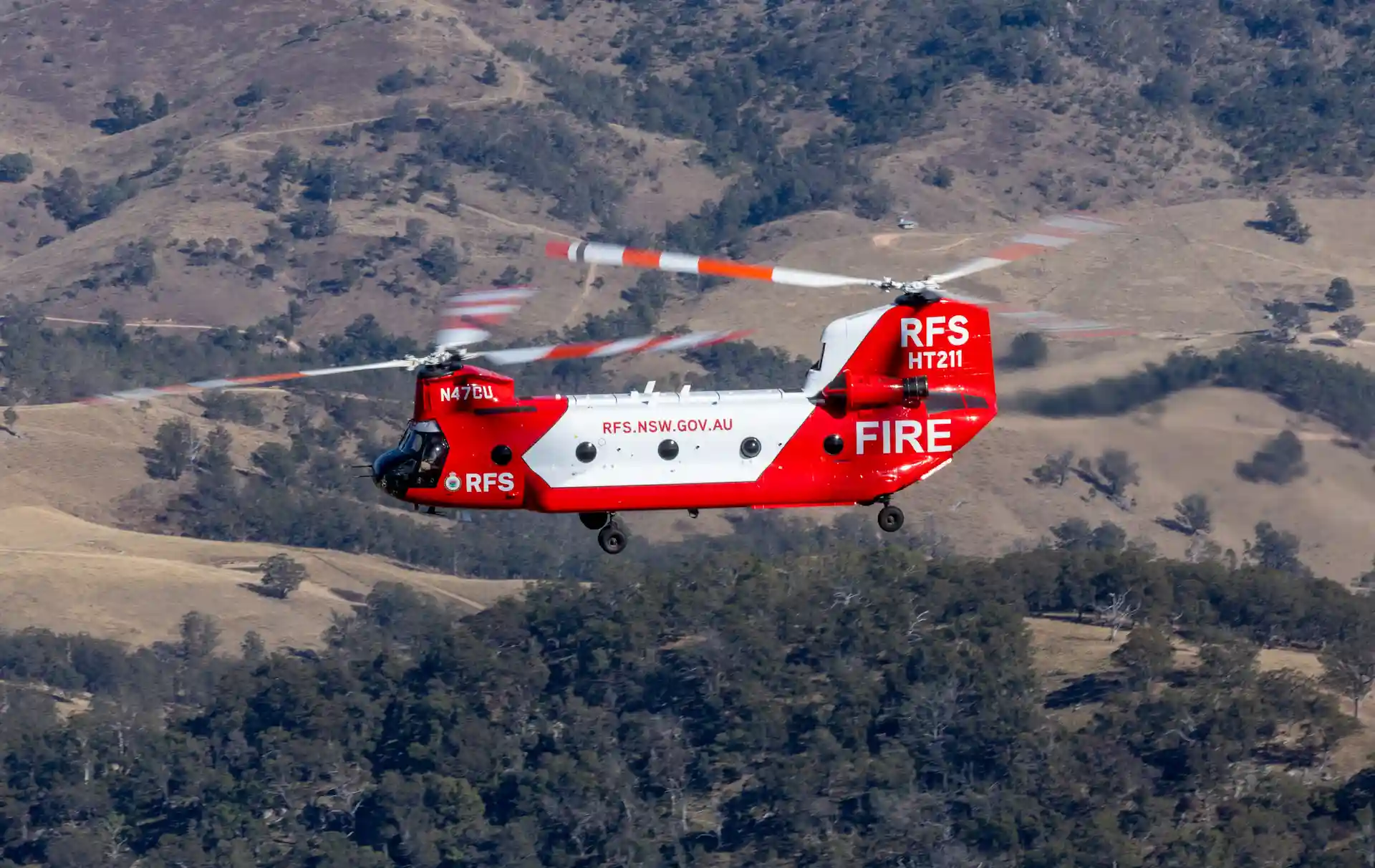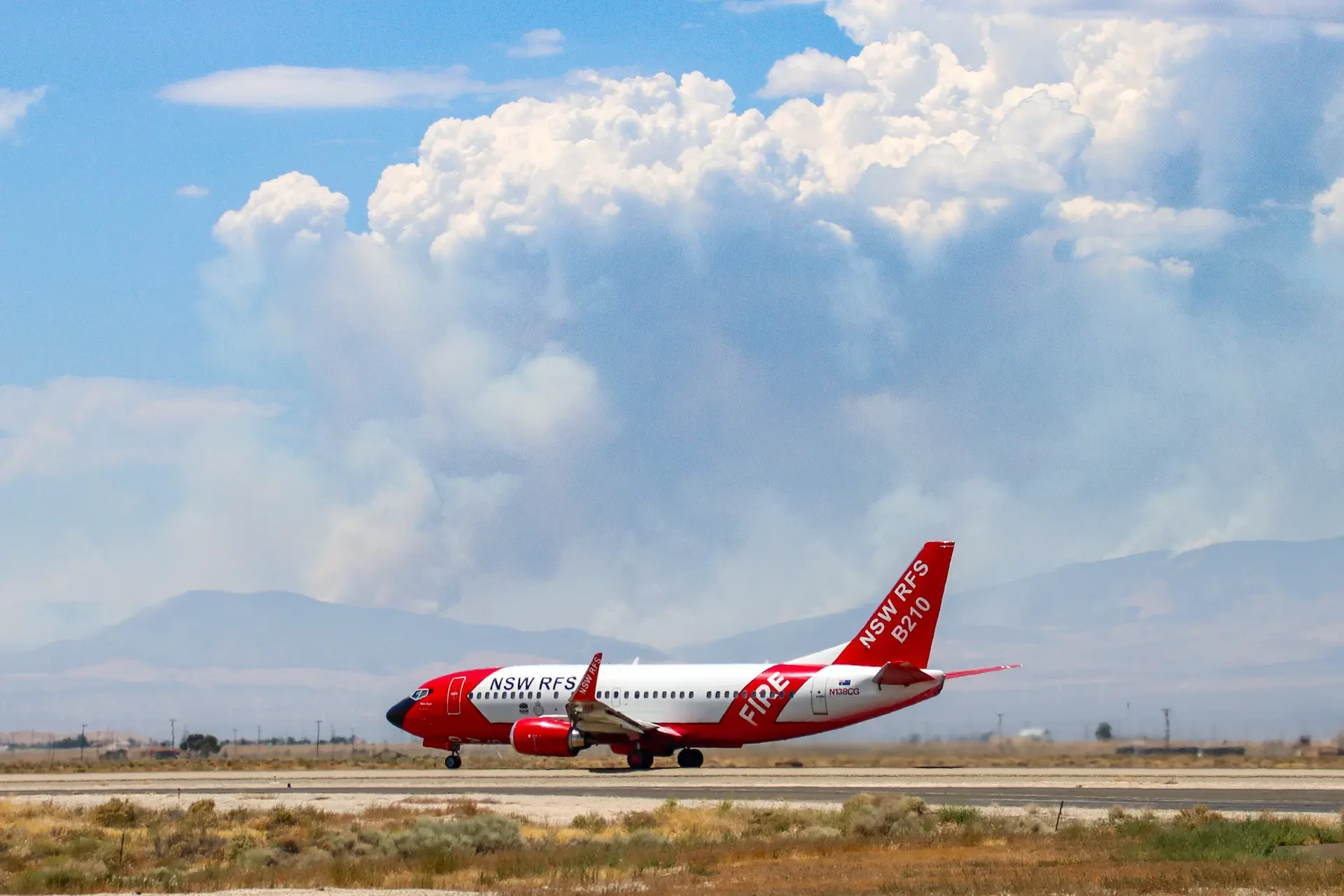The recent memorandum of understanding (MOU) between CalFire and Australia’s NSW Rural Fire Service (RFS) – the world’s largest volunteer firefighting agency – is a significant move in advancing firefighting capability, safety and efficiency for both Agencies.
The New South Wales RFS has built a significant fleet of firefighting air assets over the past several years and is undoubtedly the most significant agency involved in fighting wildfires in Australia. Although its fleet is large by Australian standards, the RFS does not attempt to displace or replace civil firefighting operators. Its aircraft primarily operate for aerial intelligence gathering, to transport firefighters and to evacuate people in trouble, using its operation of Type-1 helicopters and LATs/VLATs supplementing civil operations. It also uses air assets sourced from overseas to provide a heavier-hitting capability than the civil fleet of smaller machines. RFS Commissioner Rob Rogers elaborated, “That’s our consideration when we choose what we’re going to own. We’re not buying things like Air Tractors or Squirrels because there are plenty of them already here in the civil fleet.”

Rogers explained that an MOU between the RFS and CalFire first came about when the RFS was looking for some firefighting assistance with a LAT (large air tanker). “We were trying to work out the mechanism of how to do that. We ended up doing it originally through Coulson’s but it was even said back then that we had to have a government-to-government agreement between CalFire and us,” he related. In the process of working on an MOU it was realized that it had to be more broad-ranging than just working with a LAT, as visits from CalFire personnel made it clear that each agency was able to pass on to the other differing skills, tactics and experience. RFS Assistant Commissioner Ben Millington explained, “Obviously it all kicked off with discussions around the LAT but then we realized, why don’t we look at other programs beside the LAT?” During a number of meetings over several months, discussions established that alongside aviation cooperation, such issues as hazard reduction and management, firefighting technology and urban interface firefighting truck design would all benefit from joint collaboration under the proposed MOU.
During an October study tour to California the outline for an MOU was further fleshed out, as Millington added. “Although we went primarily to look at aviation safety, we were able to have some of those discussions about other aspects as well.” Rogers believes that one of the major benefits of the cooperative MOU will be the transfer of skills from working in the different environments, with a different organization. “I would like to see us send people over to California every year to work with them in their environment, learn from them and become more skilled by doing more of that type of work. Particularly for things like air attacks but we could extend that to air-base supervisors and the like,” he opined. “Potentially, our people could also be working there for things like fuels and incident management, looking at how they work, how they do business and picking up new skills so we can refine our processes and learn from them. I think the Californians have much the same view and it will be a win-win for both agencies.”

Commissioner Rogers pointed out that the operating and regulatory environment are vastly different for the two agencies. CalFire is only one
of many agencies that fight fires in California and has to navigate a veritable maze of competitive restrictions and requirements, whereas
the RFS is the primary firefighting agency for Australian wildfires and has a much simpler operational environment. Nevertheless, both
agencies carry out the same function on a fireground and both deploy both ground-based and aerial assets. Initial attack tactics vary,
largely due to the much denser population in CalFire’s area of coverage, so that agency tends to hit a fire much harder and faster in the
early stages. The RFS has fewer aircraft available for immediate deployment so has somewhat longer-term air attack tactics. “If we have a
fire in one of the more remote areas, there may be a single helicopter or SEAT (single engine air tanker) locally, and that’s it,” he
elaborated.
To aid in developing the MOU, CalFire was invited to the annual aerial firefighting conference in Dubbo, and they ended up sending four attendees: two aviation specialists, a director of technology and a fuel management expert. The CalFire representatives arrived early enough to spend a couple of days at RFS Headquarters with the respective RFS teams, beginning those conversations and then attending the Dubbo conference. Afterwards, they were flown over some of the high-risk fire areas and shown the types of vegetation and fuels typical in the Australian environment.
Millington summarized that the resulting MOU is extensive in scope and largely focuses on collaborating on aerial firefighting, fire
detection initiatives, communication technologies and training, sharing advances in training materials and opportunities, promoting safety,
preparedness and awareness to at-risk communities through community engagement programs, sharing best practice and expertise in the areas of
aerial firefighting, incident management systems and response and recovery efforts, and sharing and exploring emerging technologies and
innovations in hazard and fuel management methods. It specifically cites the provision of aircraft etc. during operational activities and
personnel exchanges for professional development purposes. “So, if we get busy, we could contact them and invite them to send people over to
work with us and gain experience here, and if they get busy, we could send people over there as well. From a professional development point
of view, I think that’s very useful to us,” Millington commented.

Rogers stated that he is a great believer in the RFS’ people going out to other jurisdictions, with the benefits gained far outweighing the incurred costs. Although numerous international agreements already exist for deployment of firefighters between nations in times of need, the RFS-CalFire MOU provides a simpler and more streamlined mechanism for cross-deployment of personnel other than firefighters. “My intention is to send some of our people over next year after our summer, in April or May probably,” he added. Almost all RFS firefighters are volunteers but when they are deployed to other jurisdictions – such as Canada or the US – they are required to be firefighting agency employees, so the RFS employs them for the term of their deployment and upon their return they once more become volunteers.
Due to the existing agreements for firefighter and incident management team deployments, Rogers does not foresee the MOU being a vehicle
for additional such measures, but he stressed that the possibility is always open for such an arrangement. “I foresee that for aviation,
we’ll send our air-attack supervisors and the like. For something like fire behavior, it would probably be someone that’s employed as a
fire behavior analyst, and for incident control it could be an op’s officer or an incident controller. I think who ends up going will vary
depending on what the task is at the time,” he commented.
.webp)
Rogers would like to see the cooperation between the two agencies not just continuing but expanding in scale and scope over time. “As long
as both agencies find it beneficial, there’s no reason that it shouldn’t keep developing.” He observed that, although he only got to meet
with the CalFire representatives briefly at Dubbo, it became very clear that the two organizations had gone in slightly different directions
with various aspects of the task. One area that the RFS is ahead on is the development and adoption of AI (artificial intelligence) incident
management software systems as part of its firefighting arsenal. That would allow CalFire to make a much simpler and less costly transition
to such systems if it chooses to go down that path or similarly, it could develop other systems instead and share them with the RFS. “Those
observed differences meant that we could already see that there were some things that we are doing that may be better than what they do and,
equally, there are things they do better than us that we can learn from.
When pressed to specify areas where he believes CalFire is ahead of the RFS, Rogers cited aerial firefighting in general. “They’ve got more dedicated people doing that work, I think they have better systems and they’ve just been doing that work longer than we have. Because of the frequency and intensity of their fire seasons, they’ve evolved to be ahead of us. We’re not competitors though, so we can share everything we do and learn from them. I think it’s nice that it’s a two-way thing and they value the relationship also, seeing a good linkage with our agency.” Millington remarked that he sees CalFire as forward thinking, leading the way in firefighting because it is always looking for how it can do things better. “I think that under the Commissioner we have a similar approach here in Australia, although we have a smaller fleet of eleven aircraft, compared to CalFire’s 76.” Rogers stated in conclusion that the world of firefighting is becoming smaller and that it is important to develop strategic alliances wherever possible, for all to share and benefit from combined experience, tactics, methodology and expertise.
.webp)
 HOME
HOME



